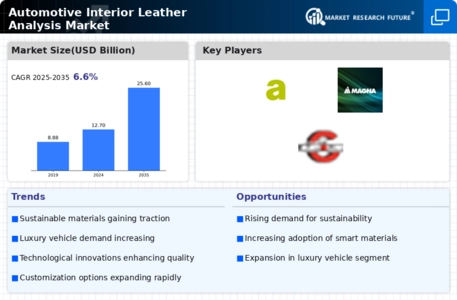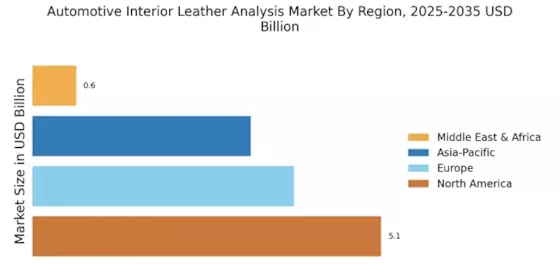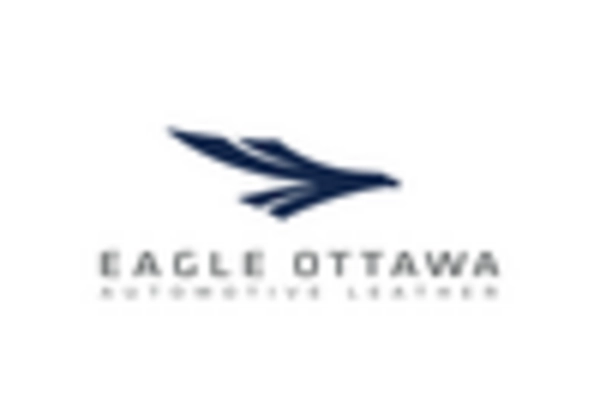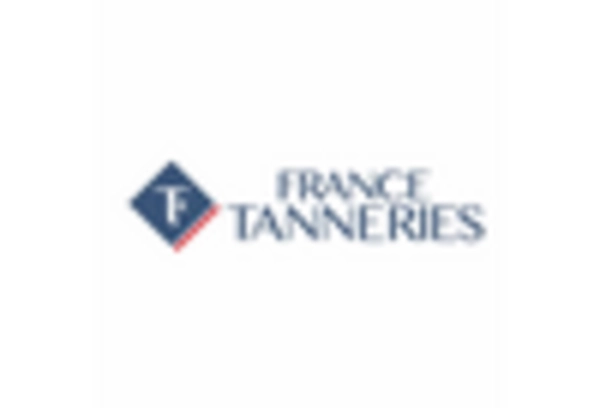Rising Demand for Luxury Vehicles
The increasing consumer preference for luxury vehicles is a notable driver for the Automotive Interior Leather Analysis Market. As more consumers opt for high-end automobiles, the demand for premium materials, including leather, escalates. In 2025, the luxury vehicle segment is projected to account for a substantial share of the automotive market, with leather interiors being a key selling point. This trend suggests that manufacturers are likely to invest in high-quality leather analysis to ensure that their products meet consumer expectations for comfort and aesthetics. Consequently, the Automotive Interior Leather Analysis Market is expected to experience growth as companies seek to enhance their offerings and maintain competitive advantages.
Regulatory Compliance and Standards
The Automotive Interior Leather Analysis Market is also driven by the need for compliance with various regulatory standards concerning material safety and environmental impact. Governments and regulatory bodies are increasingly imposing stringent guidelines on the use of materials in automotive manufacturing. This necessitates thorough analysis and testing of leather products to ensure they meet safety and environmental criteria. As a result, manufacturers are likely to prioritize investments in leather analysis to avoid penalties and enhance their market reputation. In 2025, the emphasis on regulatory compliance is expected to bolster the Automotive Interior Leather Analysis Market, as companies strive to align their products with legal requirements.
Shift Towards Sustainable Materials
The shift towards sustainable materials in the automotive industry is a pivotal driver for the Automotive Interior Leather Analysis Market. As environmental concerns gain prominence, manufacturers are increasingly exploring alternatives to traditional leather, such as plant-based or recycled materials. This transition necessitates rigorous analysis to assess the quality and performance of these new materials. Market trends indicate that by 2025, a significant portion of consumers will prefer vehicles that utilize sustainable materials, prompting manufacturers to adapt their offerings accordingly. Consequently, the Automotive Interior Leather Analysis Market is likely to expand as companies invest in research and development to innovate and analyze sustainable leather alternatives.
Consumer Awareness of Material Quality
There is a growing consumer awareness regarding the quality of materials used in automotive interiors, which serves as a significant driver for the Automotive Interior Leather Analysis Market. As consumers become more discerning, they increasingly seek vehicles that utilize high-quality leather, which is perceived as a marker of luxury and durability. This trend is reflected in market data indicating that premium leather products are experiencing higher sales growth compared to synthetic alternatives. In 2025, this heightened awareness is likely to compel manufacturers to invest in comprehensive leather analysis to ensure that their products meet the evolving expectations of consumers, thereby fostering growth in the Automotive Interior Leather Analysis Market.
Technological Advancements in Leather Production
Technological innovations in leather production processes are significantly influencing the Automotive Interior Leather Analysis Market. Advanced techniques such as digital printing and eco-friendly tanning methods are becoming increasingly prevalent. These innovations not only improve the quality and durability of leather but also align with sustainability goals. As manufacturers adopt these technologies, the demand for precise leather analysis becomes critical to ensure compliance with industry standards. In 2025, it is anticipated that the integration of these technologies will lead to a more efficient production process, thereby driving growth in the Automotive Interior Leather Analysis Market as companies strive to optimize their supply chains.


















Leave a Comment